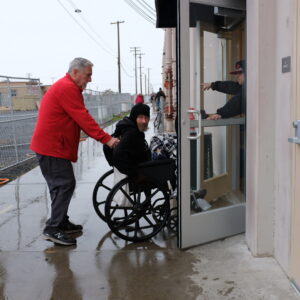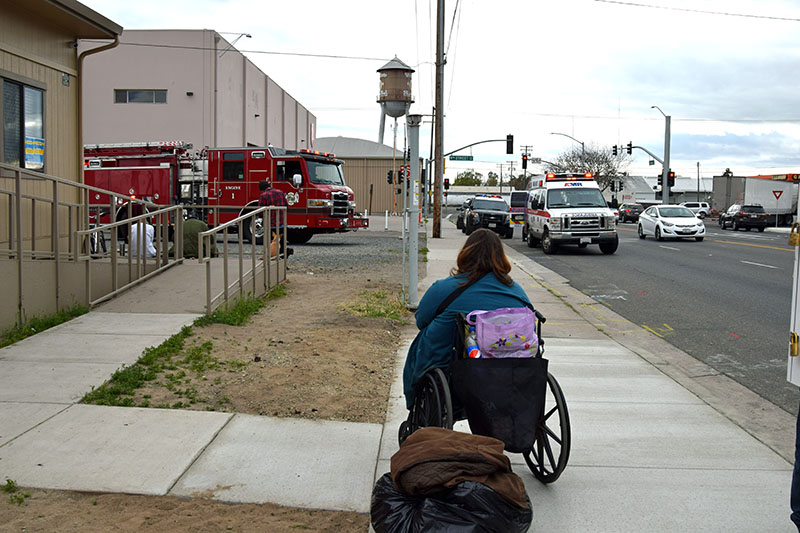“Almost all emergency shelters of today are over their heads,” said Major Harold Laubach at Modesto’s Salvation Army Shelter on November 19. “But for people with mental health issues, we are probably the best alternative. Forty percent of our residents deal with mental health challenges and another 40 percent deal with substance abuse challenges.”

Laubach was responding to a growing litany of complaints from residents of Stanislaus County’s low barrier shelter that rules are arbitrary, staff members too often look down on residents, and promises of housing have been made in bad faith. The low barrier shelter shares a building with a more traditional Salvation Army Shelter on 9th Street, near downtown Modesto.
A great many of the shelter’s problems arise from its growing role as the only alternative for mentally ill, physically disabled, and recently discharged hospital patients. Moreover, many who seek shelter have perilous health conditions when they enter.
“The fire truck and an ambulance come here almost every day,” said Laubach. Laubach also said some of today’s laws contribute to the growing burden shelters carry as the last resort for people with nowhere to go.
“By law, hospitals are required to seek beds for those experiencing homelessness before they’re discharged. Many are brought here when they still need some level of medical attention. We’ve just been approved to hire Licensed Vocational Nurses and we have already added Certified Nursing Assistants, but there are shortages of qualified people. We currently have 37 residents in wheelchairs.”
Problems also arise when residents enter the shelter drugged or drunk. Because it’s a low barrier facility, the policies are based on a client’s behavior, not their level of impairment.
“We don’t have drug or alcohol tests,” said Laubach, “but we do have metal detectors so that people can’t enter with weapons or drug paraphernalia. We otherwise have no rules about drug use, except we don’t allow it on the premises. Even so, people are sometimes able to smuggle drugs in.”
Laubach said there are very creative ways to smuggle drugs into the shelter.
“We found drugs in those household safes disguised as canned goods. We’ve had people smuggle drugs in using soda cans to conceal the drugs. And when you are working with people with addictions, we sometimes find them unconscious in the bathrooms.”

Complaints about the bathrooms are among the most common from shelter residents, despite the new ADA compliant bathrooms. When asked why he repeatedly left the shelter, the late Alan Davis said it was because he couldn’t use the bathrooms. Davis was in a wheelchair, and the bathrooms are handicapped-accessible, so few people took Davis seriously. However, there could be other issues with bathroom services, including lack of capacity for the number of residents.
“They shouldn’t have women cleaning the men’s room,” said Tyrone Thomas, a long-term resident. “I had to go and wasn’t allowed in because a woman was cleaning. It was late at night and I couldn’t wait.”
Another long-term resident, Daniel Shockley, was evicted from the shelter after another dispute involving the restrooms.
“The bathrooms were full on our (low barrier) side, so I went to the other side,” said Shockley.
“Someone knocked on the door and I said, ‘I’m almost done.’ They thought I said, ‘I’m loading a gun,’ and they kicked me out.”
Shockley’s term of eviction was shortened after consideration of his long term and good record.
“I’ve been here two years and I’ve only been written up three times,” said Shockley, still upset about the eviction.

Laubach said that in many cases, residents receive up to five warnings before further action. Given the high proportion of mentally ill residents, it’s not unusual for staff members to have to deal with petty disputes that can escalate into potentially dangerous conflicts. While there is 24/7 security on site, at times they have to take on the roles of psychologists and psychiatrists, roles for which they aren’t trained.
It’s also not unusual for staff to have to deal with disputes between spouses.
Marcus Lopez said he was evicted for arguing with his wife.
“They have cameras. They could check and see I never touched her,” said Lopez, bitter about having been ordered to leave the shelter.

Even with a robust security system with cameras, the shelter’s managers often have to rely on verbal reports from the parties involved in an argument. Such cases can easily turn into competitions where seeking the truth is less valued than seeking to avoid responsibility or blame. These kinds of controversies, if they can be resolved at all, require the kind of professional counseling or arbitration required of social workers. What are staff members supposed to do when tasked with problems even qualified experts struggle to resolve?
Given the nature of congregate living, it’s no wonder shelters everywhere are staggering under the load of responsibilities they were not designed to handle. Emergency shelters were originally conceived and constructed to deal with short-term emergencies, especially for temporarily unemployed men.
Today’s shelters have become the default alternative for the mental institutions we shut down long ago. They’ve become improvised board and care facilities and understaffed convalescent homes. They’ve even taken on the burden of caring for people priced out of the housing market due to statewide shortages of affordable housing.
For most of us, the word “emergency” suggests an urgent issue in need of quick resolution. Today’s emergency shelters often have the same residents for months at a time because there’s nowhere else to go.
The exigencies of extreme poverty, overcrowded hospitals, and broken systems of care have proven to be enduring and they’re getting even more dire. In the case of Stanislaus County’s low barrier shelter, some residents went in when it opened in November of 2019 and are still there. Given the inherent difficulties imposed by congregate living, it’s a wonder the shelters haven’t had more problems.
Even with the multitude of almost impossible challenges he faces every day, Major Harold Laubach remains firm in his opinion that shelters are today’s best option for people in distress.
“We’re still far better than the only other alternative,” he said, “which is sleeping in the street.”
Like many of today’s contemporary saints toiling in the fields of charity and compassion for compensation that amounts to a vow of poverty, Harold Laubach soldiers on, knowing full well a tsunami of need has breached the dike and risen over his head. As today’s last resort for people with nowhere to go, he will continue doing all he can to keep at least one door open.

The shelters may still be the best alternative to the streets but they should have been a step up to housing long ago. When I established the 9th st. Shelter my dream was it was step 1. The complaints of staff looking down should not be happening at all. Sad Modesto still has these problems.
The number of homeless seems to be increasing. They can be spotted in many places along freeway 99 and on North Mc Henry Avenue. Whatever is being done by government is inadequate.
The amount of garbage piling up in and around town is alarming. The streets are unsanitary. This may become a health issue and cause the proliferation of vermin. We probably need to elect new leaders as the present ones do not seem up to the task.
Thanks for the article. Keep this up. Although we don’t agree on the politics postings, your articles on homeless and water issues are spot on.
Eric,
Would love to sit down with you, if you’re willing, and discuss. Appreciate the article; I am well aware of what’s been happening lately at the low barrier shelter. Have been working weekly to make adjustments. Too much to talk about here but could fill you in if you’re interested, take care.
YES, Eric, please interview Terry Withrow, he is the man who is supposed to be IN THE KNOW of WHAT THIS COUNTY IS DOING FOR THE HOUSELESS. He seems open to discuss, at least, some of what your readers want to know. Please make the interview BROADER IN SCOPE, than ONLY what’s been happening LATELY at the low barrier shelter. Although that seems to be the topic under consideration that he is willing to SCHMOOZE about. PRESS FOR ANSWERS.
MUCH GRATITUDE, to you, ERIC CAINE, for your attention to details, having to do with the conditions facing, and created by, OUR HOUSELESS FAMILY who are being WAREHOUSED at the shelters. Found your interview of Major Harold Laubach at Modesto’s Salvation Army Shelter very worthwhile. He seems to be upfront about his thoughts. I am certain he has other, unshared, thoughts, he may not be at liberty to say.
Of much interest to know that Licensed Vocational Nurses (LVNs) can be hired. Hopefully, they will be tasked with supervising the Certified Nursing Assistants (CNAs). Although, CNAs are needed, it has been my experience with CNAs that many of them are not accountable, unless there is an in-house NURSE present to SUPERVISE the work. On-call supervision usually amounts to when the cats away the mice will play. I would very much like to see a copy of the Job Descriptions expected of each position, there at the shelter, and the schedules.
To put it as nicely as I can, just because someone is certified as a nursing assistant, it does not mean they have much training to speak of, or that they actually know how to multi-task, or that they can think on their feet, and/or that they actually apply what they do know. Who ever is doing the hiring of any staff, at the shelter, needs to have a well thought out, thorough Job Description, a savvy interviewer who is not easily snowed, and an intact period of probation, so those not in compliance with what the job entails can be immediately brought to task, or what is their use? Anyone can obtain a CNA these days, without much effort put forth. Some of what was just said, may account for exacerbating issues, on ANY health care assignment, all the more so under the pressure of so many different needs to tend to at the shelters.
PRECISELY BECAUSE OF the FACTs that HOMELESS POPULATIONS are DENIED the necessity of TRANSPARENCY and ACCOUNTABILITY with FUNDING earmarked for their needs, and NO ONE ELSES; and DENIED the necessity of having hired EXPERIENCED mental health and addiction counselors, with EXPERTISE working with, AT A MINIMUM, the DUAL-DIAGNOSED populations frequenting shelters, those tasked with ATTEMPTING to MAKE ALL THE LOSE STRINGS become a SECURE LOOP, essentially, HAVE YET TO REACH SUCCESSFUL OUTCOME.
An ORGANIZATIONAL PSYCHOLOGIST is needed to ASSESS and DIAGNOSE the very predictable problems that continue to present, and put together a plan to IMPLEMENT, all over California, and the USA.
OTHERWISE, wheels will spin, will power will implode, and WHAT WE SEE is WHAT WE HAVE GOTTEN and MORE THAN LIKELY, WHAT WILL CONTINUE FOWARD.
UNLESS THERE IS PURPOSE FOR SOME TO WANT TO KEEP THIS CRISIS GOING, ALL THIS PUSSY FOOTING AROUND MUST CEASE AND DESIST, IMMEDIATELY…
QUITE FRANKLY, I AM TIRED OF EXCUSES,.HENCE, IF THAT IS ALL, DISTRICT 3 SUPERVISOR, TERRY WITHROW, WHO, ALSO, SERVES ON, THE STANISLAUS HOMELESS ALLIANCE, CAN, OR IS WILLING TO OFFER, THEN, OUR HOUSELESS FRIENDS, ARE IN MUCH DEEPER WATER THAN THEY HAVE ALREADY BEEN DOING THE DEADMAN’S FLOAT IN.
AND, UNFORTUNATELY, THERE ARE MANY MORE INDIVIDUALS AND FAMILIES WHO ARE DUE TO BE JOINING THE RANKS OF THE HOUSELESS. ABSOLUTELY NO THANKS TO COMMISSIONER BEESON, WHO OPERATES OUT OF THE TURLOCK DIVISION OF STANISLAUS COUNTY, SUPERIOR COURT’s, LANDLORD-TENANT, FIASCO.
Let me shine some much needed light into CA’s, COVID RENT REIMBURSEMENT to landlords, and SLUMLORDS. That reimbursement process is ending in December 2021, unless legislators extend it. I listened to a CA legislator, being interviewed on podcast, who may be the most well-informed when it comes to the COVID REIMBURSEMENT process, yet he seemed to not truly know much. Stanislaus County may have a process different than what is available in most of CA. The STAN CO process may be more complicated and more difficult to obtain a successful outcome OF REIMBURSEMENT TO LANDLORDs.
PLUS, all CA tenants who experienced hardship paying rent during GOV. NEWSOM’s EVICTION MORATORIUM, were required to fill out and verify, by signature, a DECLARATION stating they experienced hardship due to COVID, if true, which makes sense. But the HITCH is that the landlord can file, using the DECLARATION, in SMALL CLAIM’s COURT, before COMMISSIONER BEESON, and obtain JUDGMENT up to $10,000.00.
I DO NOT BEGRUDGE LANDLORDs from RECOUPING RENT. YET, I DO THINK TENANTS SHOULD HAVE BEEN MADE FULLY AWARE OF THE FACT THAT, ALL THE WHILE, WHEN GOV. NEWSOM WAS TELLING TENANTS THEY WOULD NOT BE EVICTED, AND THAT RENTS WOULD BE REIMBURSED TO THEIR LANDLORDs, TENANTS WERE REQUIRED TO FILL IN A SPECIFIC DECLARATION FORM, MAIL IT TO THEIR LANDLORD. WHAT GOV. NEWSOM, LEFT OUT, WAS THAT, IF, AND WHEN, THE RENT REIMBURSEMENT WAS SO LATE IN COMING, OR NOT FULFILLED AT ALL, THEY WOULD BE TAKEN THROUGH THE SMALL CLAIM’s MILL. THE DECLARATION IS THE KEY DOCUMENT IN SMALL CLAIMS.
I BELIEVE THAT IF TENANTs KNEW THE WHOLE PROCESS, THEY MAY HAVE ELECTED TO MOVE OUT IN ORDER TO PREVENT GETTING BURDENED WITH JUDGMENT FOR BACK RENT. I UNDERSTAND, THAT IS PRECISELY WHAT CA, GOV. NEWSOM, WAS TRYING TO PREVENT: MORE HOMELESS PEOPLE LIVING ON THE STREETS, ESPECIALLY DURING COVID, YET HE WAS, AND IS STILL, LIABLE FOR NOT FULFILLING HIS OBLIGATION AND RESPONSIBILITY TO NOTIFY TENANTS OF ALL RAMIFICATIONS. BECAUSE HE DID NOT, TIMELY NOTIFY, TENANTS, THEY WILL HAVE A JUDGMENT ON THEIR CREDIT, THAT WILL WORK AGAINST THEM LOCATING ANOTHER RENTAL. TENANTS HAD A RIGHT TO KNOW THIS WOULD BE HOW IT WOULD GO DOWN.
I can imagine that few people will care what happens to tenants, with all the other worries they themselves are faced with. YET, TENANTs NEEDED TO KNOW, IN ORDER TO MAKE WISE DECISIONS. TENANTS HAVE RIGHTS, TO KNOWLEGE.
AND, THE ENTIRE EVICTION PROCESS, SINCE THE EVICTION MORATORIUM ENDED, IS FRAUGHT WITH NEW RULES, THAT SERIOUSLY OBSTRUCT A TENANT FROM PREVENTING BEING EVICTED. ON-LINE INFORMATION CONTINUOUSLY POINTS TENANTS, SUMMONED TO EVICTION COURT, TO CONSULT A LAWYER OR THE SELF-HELP PROGRAM TO LEARN HOW TO PROCEED PRIOR TO COURT TRIAL.
THESE SCANT RESOURCES WERE NEXT TO USELESS, PRIOR TO COVID, BUT, IT IS MUCH MUCH WORSE, SINCE COVID. THE SELF-HELP DESK WAS OFTEN, IF NOT ALWAYS, LIMITED IN TIME, STAFF, SOLID INFORMATION, THUS, THEY NEVER WERE OF MUCH HELP, BUT NOW THEY ARE INUNDATED WITH TENANTS WHO NEED WHAT LITTLE HELP THEY WILL BE GIVEN THERE.
AS FOR LEGAL CONSULTATION, FOR THE LOW INCOMED, THE FEW LEGAL AIDE GROUPS, AVAILABLE TO CONSULT, WILL ONLY HELP TENANTS FILL OUT THE FINAL DOCUMENT THAT SHEWS THEM DIRECTLY BEFORE THE EVICTION COMMISSIONER, RATHER THAN HELP TENANTs EXHAUST ALL THEIR LEGAL REMEDIES, WHICH IS NECESSARY IN ORDER TO APPEAL THE DECISIONS MADE AT THE DISCRETION OF A JUDGE. THESE LEGAL AIDE GROUPS, RARELY, IF EVER, ACTUALLY REPRESENT A TENANT. THEY SEND THEM OFF LIKE SHEEP TO THE SLAUGHTER, HAVING TO DEFEND THEMSELVES WITH THE ONLY DOCUMENT THEY WERE HELPED TO FILL OUT.
EVEN ATTORNEY’s ARE ADVISED TO NEVER DEFEND THEMSELVES. YET, A TENANT IS GIVEN CHOICE TO MOVE ONTO THE STREETS, OR FIGHT FOR THEIR RIGHTS WITH LITTLE, OR NO, INFORMATION TO DEPEND ON. WHAT IS WORSE SINCE COVID, EVEN THE JUDGEs/COMMISSIONERs HAD TO BE TRAINED ABOUT THE NEW COURT RULES, WHICH THEY ARE LIKELY NOT CLEAR ON, THEMSELVES. IT SPELLS HOUSELESSNESS FOR MOST TENANTs and FAMILIES.
WHEN TENANTs RESEARCH FOR AN ATTORNEY WHO PRACTICES LANDLORD-TENANT LAW, THEY FIND THAT THESE ATTORNEYs OFTEN ONLY RESPRESENT LANDLORDS. A TENANT HAS TO GO OUT OF THE COUNTY TO LOCATE A TENANT’S ADVOCATE, WHO IS MORE THAN LIKELY NOT WILLING TO TAKE A CASE HEARD IN STAN CO.
EVEN IF THE TENANT HAD THE MONEY TO HIRE A BONAFIDE TENANT ADVOCATE. IT IS ALL A FARCE. LANDLORDs ARE NOT COMPELLED TO MAINTAIN THEIR RENTALS BECAUSE WHO IS GOING TO MAKE THEM. NOT A STANISLAUS CO COMMISSIONER OR JUDGE. I WOULD INVITE ANYONE INTERESTED TO SIT IN COURT AND WATCH THE KANGAROO COURT PROCESS. IT IS AN ASSEMBLY LINE OF SHEERING SHEEP AND CUTTING THROATS. PROBLEM WITH THAT IS THAT NOW, DURING COVID, ONLY PEOPLE WHO NEED TO BE IN COURT, ARE ALLOWED. FOR NOW IT IS ALL CLOAKED.
IT IS ONLY UPON APPEAL, AFTER BEING EVICTED, AND MOVED OUT ON THE STREETS, WITH BELONGINGS, AND PETS, IF ANY, THAT AN APPEAL WILL BE HEARD, IF NOT RUBBER STAMPED DENIED OF A HEARING. AND, THE APPEAL REQUIRES THAT A TENANT EXHAUSTED THEIR LEGAL RIGHTS, PRIOR TO FILING THE FINAL DOCUMENT BEFORE TRIAL. VERY FEW APPEALS ARE EVER HEARD ON A TENANT’S BEHALF, AND THE LOWER COUNTY COURTS AND THE LANDLORDS AND THEIR LAWYERS KNOW THIS TO BE FACTUAL.
DURING APPEALS MANY LOWER COURT CASES DO GET OVERTURNED OR SENT BACK BEFORE THE LOCAL COURT TO ADJUDICATE LEGALLY. THAT IS NON-EVICTION CASES. UNFORTUNATELY, SELDOM WILL THIS EVER BE DONE ON A TENANT’s BEHALF. TENANTS END UP ON THE STREET, BECAUSE THEY HAVE AN EVICTION AND POOR CREDIT, AFTER JUDGMENTS ARE ALLOWED VIA THE COURT WHIELDING ITS DISCRETION.
HAPPY THANKSGIVING BLESSINGS. PLEASE HUMBLE YOURSELVES AND PRAY THAT ALMIGHTY GOD HEALS OUR LAND. IT IS IN VERY POOR CONDITION.
Always glad to hear from you Root Matters; however, perhaps you could keep the comments around 500-600 words in the future. We need to leave room for others. Again, always glad to hear from you, but maybe keep comments more concise and thank you.
WILL DO, ERIC. YOUR POSTS MOTIVATE MY VOICE AGAINST INJUSTICE
Thank you Root; very happy to see your comments always; we just need to keep the comments readers moving along. Again, thank you for your participation in our project of community journalism.
Eric Caine ,another great Article I am a former Low barrier shelter resident And in a wheelchair The Bathroom door was difficult for me to pull open to enter then having to manage not only the door but my wheelchair to Going in and out I hurt myself several times
Thank you Shonnia. We have heard many similar stories about the bathroom door. We’re hoping county officials will work on a solution.
After reading, ask yourself, “How can we better serve the most vulnerable people in our community? What can we do?” Clearly what we have been doing works for some but fails too many, especially the mentally ill, physically and mentally disabled, the elderly and the infirm.
Do we just want them out of sight or do we really want to provide them the help they need to improve their lives to whatever degree is possible?
What kind of community do we want to be known as?
My option is to embrace them as fellow humans who in many cases are broken and need to be healed to whatever level possible. The first step is to get them appropriate shelter as soon as possible.
We have thousands of folks in the county who now live literally unsheltered, as well as in emergency shelters, in vehicles and travel trailers, and who couch surf. Many bed down on our streets and in our parks. They have nowhere to go and often lack access even to a rest room.
With leadership and political will, we can strengthen our community and do it quickly by providing cost effective, non-congregate community shelter. Costs are efficient in several ways, but especially insofar as current costs to get people inside are astronomic and soaring.
Rough specs for transitional housing options can be from 64-400 sq/ft’; most feature quick set-up, and, costed out, prove to be more cost-effective than current approaches and traditional future options such as permanent housing, which takes years. The market place has many viable alternatives, such as palletshelter.com, boxabl.com, and, if you’re really interested in options, go to the Innovation Showcase site. Here are some examples of of pallet shelter villages in CA.
Lastly, there are at least four different housing planning projects on-going in the county/cities and none address the issue of this type of housing adequately, if at all! But we don’t need expensive and lengthy planning projects do deal with this critical emergency, we just need to do it!
Since it’s a weekend, a bonus read: A Portland pallet shelter village
Thank you, Frank, for your reply, and for your suggestion for a bonus read. I was not able to locate, yet, A Portland pallet shelter village, if that is a specific title. Yet, I was able to locate in the Portland Tribune, a September 14, 2021 read, titled: Development pushes out Portland’s ‘C3PO’ homeless villages. It was a rather thorough read that hit upon encouraging information about villages utilizing pallet shelters. The cost’s with HVAC per pallet shelter was far less in expense than what I have heard tossed about for a permanent unit and a far quicker timeline for erecting. BUT, the combined operating costs per month is difficult to swallow. Not that I am a cold hearted miser but I cannot get out of my mind the thought that all the money going out for operating costs can somehow be reduced with better planning. This is Modesto that is Portland: ka-ching!
Two, take-aways, and there were many, in the Portland Tribune, are the following:
Kate Merrill, executive director at the Central Eastside Industrial Council, said that even after City Hall approved the Shelter to Housing Continuum that legalized many forms of alternate shelter, it would have been difficult for the villages to persist on land zoned for industrial uses. Merrill may have been referencing the fact that the pallet shelter villages were temporarily placed on industrial zoned property. Meaning the pallet villages could be displaced, when an industrial business wanted to make use of the property. Having pallet shelter villages set up on hot blacktop is better than set up: nowhere, BUT with vacant grassed lots around it seems there are better locations. It depends on circumstances, I suppose.
Highlighting the best for last, the point that most stood out, in Merrill’s comment, is that City Hall approved the Shelter to Housing Continuum that legalized many forms of alternate shelter. Has Modesto, or Stanislaus County, or, any of the locations within the this valley, legalized many, or any, forms of alternate housing specific to housing our Houseless folks? I may be wrong, yet it seems that there are such tight reigns being kept. So tight and restricted are the reigns that the Homeless Community is being set up to fail, in fulfilling the hopes or expectations of home dwellers, no matter what they do to locate alternative shelter. We have all heard the saying, “Can’t win for losing.”
Lou, the story link https://www.oregonlive.com/portland/2021/11/new-homeless-village-site-announced-on-portlands-west-side.html